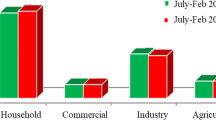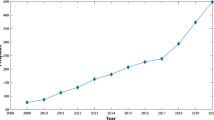Abstract
The main purpose of the present study is to develop a simple yet proper top-down model for forecasting the energy demand of the residential and commercial sectors in Iran. This model can be used as a tool of scenario analysis to predict the emerging energy demand in future. The proposed model would be systematically developed and selected based on various quantified exogenous variables. For this purpose, a certain model out of a collection of 41,472 parallel models with different inputs and dynamics is chosen as the most appropriate model. According to the logical conjunctive relationships between the variables, the structure of all competing models is established to log-linear. Different possible combinations of various measures for the exogenous variables generate parallel models. Then, an automated fuzzy decision-making (FDM) process determines the best model. Finally, defining several scenarios, the energy demand of the residential and commercial sectors in Iran for the period of 2013 to 2021 is forecasted. The results showed that despite of de-subsidization, which is included by a dummy variable, the energy demand will grow by an average rate of about 3 % annually.





Similar content being viewed by others
Notes
Since 1980 till present, the average 10-year share of industrial sector from total value added of the country has been increased by almost 10 % each decade.
Kwiatkowski–Phillips–Schmidt–Shin test
Abbreviations
- AAEP:
-
Average absolute error percentage
- BIRR:
-
Bilion Iranian Rials
- BLD:
-
Book value of active buildings [104 BIRR]
- BU:
-
Bottom-up
- D:
-
Differencing operator
- DC:
-
Dynamicity criterion or the property index for the dynamics of a model
- DUM:
-
Dummy variable
- ER:
-
Energy consumption by the residential and commercial sectors [MTOE]
- FIT:
-
Fitness of simulation
- FPE:
-
Akaike’s final prediction error
- GT:
-
The global Student t statistics
- HNT:
-
Household number [million persons]
- HVAC:
-
Heating, ventilation, and air conditioning
- INVC:
-
Gross fixed capital formation (investment) for the constructions [104 BIRR]
- JB:
-
Jarque-Bera tests of normality
- KBLD:
-
Cumulative sum of BLD [104 BIRR]
- KCD:
-
The same variable (KCT) calculated considering a 5 % annual depreciation rate
- KCT:
-
Total capital invested for buildings (constructions) [104 BIRR]
- L:
-
Logarithm
- LB:
-
Ljung-Box independence statistics
- LBR:
-
Labor [million persons]
- MTOE:
-
Million (metric) tons oil equivalent
- OLS:
-
Ordinary least squares
- ONE:
-
A vector of “ones” with an appropreate dimension
- PAPL:
-
Electrical and fuel appliance price index; PAPL(1997) = 1
- PDF:
-
Possibility distribution function
- PEM:
-
Prediction error method
- PFC:
-
Consumer energy (fuel) price index; PFC(1997) = 1
- PFPG:
-
Energy price index adjusted (deflated) by the general price index; PFPG(1997) = 1
- PNL:
-
Population minus the labor [million persons]
- PO:
-
Population [million persons]
- PP:
-
Prediction power
- PS:
-
Power spectrum
- P th :
-
Norm of covariance matrix of the parameters
- R 2 :
-
Adjusted explanatory power
- SP:
-
Simulation power
- TD:
-
Top-down
- T min :
-
The least Student t statistics among all
- U(x):
-
The utility function
- VAN:
-
The total value added minus that of the oil sector [103 BIRR]
- VAT:
-
Value added of all economic sectors (total value added) [103 BIRR]
- YNI:
-
The national income [103 BIRR]
References
Aras, H., & Aras, N. (2004). Forecasting residential natural gas demand. Energy Sources, 26, 463–472.
Bilgili, M., Sahin, B., Yasar, A., & Simsek, E. (2012). Electric energy demands of Turkey in residential and industrial sectors. Renewable and Sustainable Energy Reviews, 16, 404–414.
Canyurt, O. E., Ozturk, K. H., Hepbasli, A., & Utlu, Z. (2005). Estimating the Turkish residential–commercial energy output based on genetic algorithm (GA) approaches. Energy Policy, 33(8), 1011–1019.
Catalina, T., Virgone, J., & Blanco, E. (2008). Development and validation of regression models to predict monthly heating demand for residential buildings. Energy and Buildings, 40(10), 1825–1832.
Catalina, T., Iordache, V., & Caracaleanu, B. (2013). Multiple regression model for fast prediction of the heating energy demand. Energy and Buildings, 57, 302–312.
Cuddihy, J., Kennedy, C., & Byer, P. (2005). Energy use in Canada: environmental impacts and opportunities in relationship to infrastructure systems. Canadian Journal of Civil Engineering, 32(1), 1–15. doi:10.1139/l04-100.
Dilaver, Z., & Hunt, L. C. (2011). Modelling and forecasting Turkish residential electricity demand. Energy Policy, 39, 3117–3127.
Donatos, G. S., & Mergos, G. J. (1991). Residential demand for electricity: the case of Greece. Energy Economics, 41–47.
Energy Balance Sheet 2011 (2012). Energy Planning Department, Deputy of Electricity and Energy Affairs, Ministry of Energy, Islamic Republic of Iran.
Forouzanfar, M., Doustmohammadi, A., Menhaj, M. B., Hasanzadeh, S., & Shakouri G., H. (2010). Modeling and estimation of the natural gas consumption for residential and commercial sectors in Iran. Applied Energy, 87, 268–274.
Grasa, A. A. (1989). Econometric model selection: A new approach. Norwell: Kluwer.
Halicioglu, F. (2007). Residential electricity demand dynamics in Turkey. Energy Economics, 29, 199–210.
Hsing, Y. (1994). Estimation of residential demand for electricity with the cross-sectionally correlated and time-wise autoregressive model. Resource and Energy Economics, 16, 255–263.
Hydrocarbon Balance 2010, (2011). Institute for International Energy Studies (IIES), Ministry of Petroleum, Islamic Republic of Iran.
Jung, T. Y. (1993). Ordered logit model for residential electricity demand in Korea. Energy Economics, 205–209.
Kavgica, M., Mavrogiannia, A., Mumovica, D., Summerfieldb, A., Stevanovicc, Z., & Djurovic-Petrovicd, M. (2010). A review of bottom-up building stock models for energy consumption in the residential sector. Building and Environment, 45(7), 1683–1697.
Kazemi, A., Shakouri G., H., Menhaj, M. B., Mehregan, M. R., Neshat, N. (2010). A multi-level artificial neural network for residential and commercial energy demand forecast: Iran case study. International Conference on Management Technology and Applications, 24–28.
Kheirkhah, A., Azadeh, A., Saberi, M., Azaron, A., & Shakouri, H. (2013). Improved estimation of electricity demand function by using of artificial neural network, principal component analysis and data envelopment analysis. Computers & Industrial Engineering, 64(1), 425–441.
Kialashaki, A., & Reisel, J. R. (2013). Modeling of the energy demand of the residential sector in the United States using regression models and artificial neural networks. Applied Energy, 108, 271–280.
Lam, J. C. (1998). Climatic and economic influences on residential electricity consumption. Energy Conversion and Management, 39(7), 623–629.
Ljung, L. (1987). System identification: Theory for the user. Prentic Hall.
Moradi, M. A., Shakouri G., H., Aboutaleb, A. M. (2013). Developing the electricity demand model for Iran’s residential sector; based on LEAP, 28th International Power Systems Conference, Tehran, Iran.
Nakajima, T., & Hamori, S. (2010). Change in consumer sensitivity to electricity prices in response to retail deregulation: A panel empirical analysis of the residential demand for electricity in the United States. Energy Policy, 38, 2470–2476.
Narayan, P. K., Smyth, R., & Prasad, A. (2007). Electricity consumption in G7 countries: a panel cointegration analysis of residential demand elasticities. Energy Policy, 35, 4485–4494.
Overcash, M., & Bawaneh, K. (2013). Estimating nonprocess energy from building energy consumption. Energy Efficiency, 6, 21–33.
Ozturk, H. K., Canyurt, O. E., Hepbasli, A., & Utlu, Z. (2004). Residential–commercial energy input estimation based on genetic algorithm (GA) approached: an application of Turkey. Energy and Buildings, 36, 175–183.
Pourazarm, E., & Cooray, A. (2013). Estimating and forecasting residential electricity demand in Iran. Economic Modelling, 35, 546–558.
Poyer, D. A., & Williams, M. (1993). Residential energy demand: additional empirical evidence by minority household type. Energy Economics, 93–100.
Rapanos, V. T., & Polemis, M. L. (2006). The structure of residential energy demand in Greece. Energy Policy, 34, 3137–3143.
Rodger, J. A. (2014). A fuzzy nearest neighbor neural network statistical model for predicting, demand for natural gas and energy cost savings in public buildings. Expert Systems with Applications, 41, 1813–1829.
Ruijven, B., Vries, B., Vuuren, D. P., & Sluijs, J. P. (2010). A global model for residential energy use: uncertainty in calibration to regional data. Energy, 35, 269–282.
Saad, S. (2009). Electricity demand for South Korean residential sector. Energy Policy, 37, 5469–5474.
Shahmoradi, A., & Shakouri G., H. (2010). Investigation on the impact of an energy desubsidization shock on the general price index via a nonlinear inflation model: case of Iran. Iranian Economic Review, 15(27), 33–51.
Shakouri G., H., & Menhaj, M. B. (2008). A systematic fuzzy decision-making process to choose the best model among a set of competing models. IEEE Transactions on Systems, Man, and Cybernetics - Part A: Systems and Humans , 38(5), 1118–1128.
Shakouri G., H., Rastad, M., & Nazarzadeh, J. (2006). A hybrid nonlinear model for the annual maximum simultaneous electric power demand. IEEE Transactions on Power Systems, 21(3), 1069–1078.
Shakouri G., H. (2000). Modeling and identification of Iranian macroeconomic dynamic system (systems approach), Ph.D. Dissertation, Amirkabir University of Technology.
Soldo, B., Potocnik, P., Simunovic, G. Saric, T., Govekar, E. (2013). Improving the residential natural gas consumption forecasting models by using solar radiation. Energy and Buildings, In Press, Accepted Manuscript, Available online 20 Nov 2013.
Statistics; Central Bank of Iran (CBI) (2012). Available at: http://www.cbi.ir/section/1372.aspx. Accessed 20 Aug 2014.
Swan, L. G., & Ugursal, V. I. (2009). Modeling of end-use energy consumption in the residential sector: a review of modeling techniques. Renewable and Sustainable Energy Reviews, 13, 1819–1835.
Taspınar, F., Celebi, N., & Tutkun, N. (2013). Forecasting of daily natural gas consumption on regional basis in Turkey using various computational methods. Energy and Buildings, 56, 23–31.
Yoo, S. H., Zhu, K., Lee, J. S., & Kwak, S. J. (2007). Estimation of residential electricity demand function in Seoul by correction for sample selection bias. Energy Policy, 35, 5702–5707.
Yu, S., Zhu, K., & Zhang, X. (2012a). Energy demand projection of China using a path-coefficient analysis and PSO-GA approach. Energy Conversion and Management, 53(1), 142–153.
Yu, S., Wei, Y. M., & Wang, K. (2012b). Prediction of China’s coal production—environmental pollution based on a hybrid genetic algorithm-system dynamics model. Energy Policy, 42, 521–529.
Zhang, Q. (2004). Residential energy consumption in China and its comparison with Japan, Canada, and USA. Energy and Buildings, 36, 1217–1225.
Zhaoa, X., Lia, N., & Ma, C. (2012). Residential energy consumption in urban China: a decomposition analysis. Energy Policy, 41, 644–653.
Ziramba, E. (2008). The demand for residential electricity in South Africa. Energy Policy, 36, 3460–3466.
Acknowledgments
The authors are thankful of the private company Idam Consulting Group (ICG) and the Institute for Research, Environment and Sustainability (IRES), UBC, for their supports.
Author information
Authors and Affiliations
Corresponding author
Rights and permissions
About this article
Cite this article
Shakouri G., H., Kazemi, A. Selection of the best ARMAX model for forecasting energy demand: case study of the residential and commercial sectors in Iran. Energy Efficiency 9, 339–352 (2016). https://doi.org/10.1007/s12053-015-9368-9
Received:
Accepted:
Published:
Issue Date:
DOI: https://doi.org/10.1007/s12053-015-9368-9




